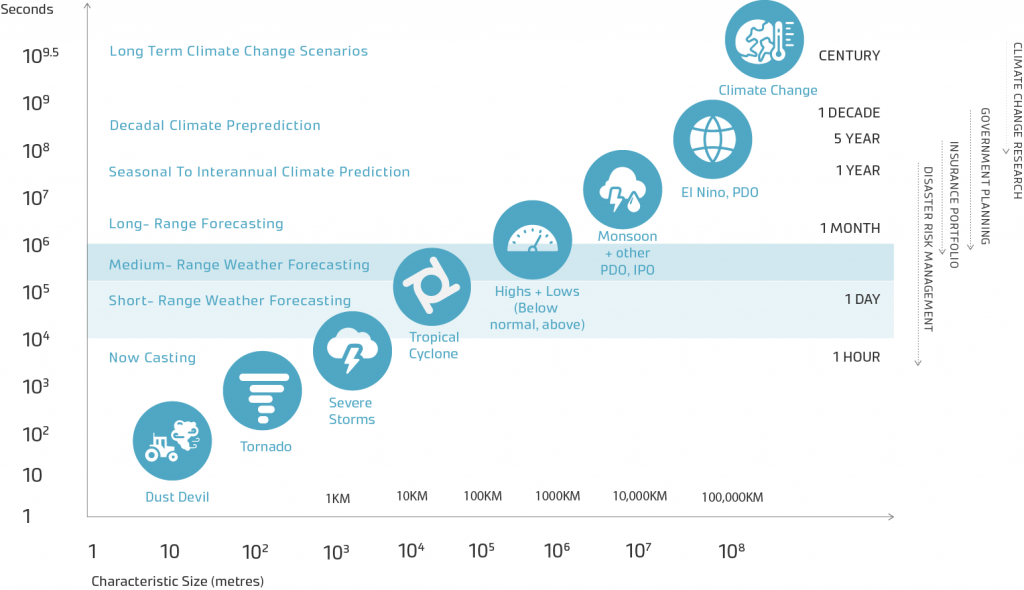
This article is part of the ISC’s Transform21 series, which will explore the state of knowledge and action, five years on from the Paris Agreement and in a pivotal year for action on sustainable development.
The conclusions of the Sixth Assessment Report (AR6) issued by the Intergovernmental Panel on Climate Change (IPCC) Working Group 1 emphasize that our commitment to reach net-zero greenhouse gas emissions by 2050 needs to be stronger than ever, meaning that we can only achieve the long-term temperature goals identified in the Paris Agreement to limit global warming to 1.5°C through immediate, rapid and large-scale reductions in greenhouse gas emissions.. The main findings are consistent with the Fifth Assessment Report (AR5), but highlight the urgency of achieving carbon neutrality while also adapting to the many unavoidable effects of climate change. Minimizing climate change vulnerabilities and risks depends on actionable, accessible and authoritative weather, water and climate services providing information on how environmental conditions and associated hazards may affect socio-economic activities and the environment.
There are three typical climate risk types with potential financial consequences delineated by the Financial Stability Board’s Task Force on Climate-Related Financial Disclosures (TCFD): physical risk, transitional risk and liability risk. The TFCD recommends consideration of macroeconomic shocks or financial losses caused by storms, droughts, wildfires and other extreme events, or by the changing weather patterns. However, this consideration is not often used in organizational climate risk assessments, except in the insurance industry. The complexity of determining climate-related physical risk is significant. Identifying climate risk consistently and accurately is necessary to inform disclosure.
While significant advancements have been made, forecasting short-range (days-week-months-years) climate-enhanced extreme weather events is still a gap in traditional natural hazard and climate risk assessments. The need for improved weather and climate change information to inform multiple hazard risk assessment and subsequently evidence-based decision making has never been stronger. Seamless integration of weather and climate information for risk assessment is critical as the climate’s atmospheric and oceanic motions and the extreme weather they can generate are interconnected [1]. The potential increase in the occurrence and intensity of extreme weather events as a result of climate change and the increasing population in vulnerable areas only reinforces this need.
Forecasting the impacts of short-, medium- and long-term climate variability and their relationship to extreme weather events would provide forward-looking, decision-useful information that can be included in risk planning and management.
Every year, weather-related hazards such as cyclones, floods, heatwaves, droughts, and tornadoes cause billions of dollars of damage and affect millions of people in both developed and developing countries. Regular extreme weather events have a larger aggregate impact on society and affect everyone everywhere. The benefits of seamless hydrometeorological predictions are proven in many parts of the world (e.g., in Kiribati, Ghana, Philippines) and are currently under research (Wetterhall et al., 2018; Fakhruddin et al., 2021) (Figure 1). Valuations of weather and climate services often apply agro-economic models to simulate potential benefits (Barrett et al., 2021). Integration of climate and weather information-enhanced medium-range and long-range weather forecasts were successfully applied in agriculture and humanitarian sectors (e.g., in Bangladesh, Indonesia, USA, EU). In Bangladesh, a US$1 investment in 1-10 days flood forecasting brought US$40 worth of benefits to the community (Fakhruddin et al., 2015). Weather and climate products are the foundation of climate risk management and adaptation to climate variability while simultaneously building resilience for sustainable development.

Weather and climate services help communities to be forewarned about the climate system for societal benefit, which helps improve public health and safety of people, expand economic opportunities, protect environmental resources, and promote national security. Weather and climate services include weather forecasts and warnings; flood and drought prediction and monitoring; natural hazard preparedness and response; public health monitoring; disease prevention and control; assessment and management of fire risk; and decision support for water resources, agriculture, transportation, and other economic sectors. Observations, science, and services related to weather and climate support the efforts to meet basic human needs (for food, shelter, energy, health and safety) and help create opportunities for socio-economic advancement.
The world is moving to the Fifth Industrial Revolution, a new Renaissance Age (WEF, 2019). New technology is emerging to ensure creativity and common purpose to use for open access and FAIR (i.e., findable, accessible, interoperable and re-usable) principles. Research and practitioner communities have long been waiting for an interoperable, open access, transparent, intuitive, flexible, collaborative, reliable, expert supported, secure, open-sourced, fast and user-friendly visual platform for risk assessment. Several initiatives has been taken. However, there are still lack of proper planning and sustainable operations and computing infrastructure for high-resolution global ensembles forecasts and enhancement of National Meteorological and Hydrological Services (NHMSs).
A collaborative platform to understand climate change and weather impacts is essential for climate intelligence. This kind of platform could draw from multiple data-driven computational models for different timescales (hours, days, weeks, months, years, decades and century). These computational models are based on local, regional and global climate and weather prediction model data, linked to exposure and vulnerability. A seamless integration of weather and climate products (short-range, medium-range and long-range forecasting) can better support the decision-making process for users by helping them understand the short-, medium- and long-range risks and uncertainties. This platform could target climate-related hazard forecasting and scenario-based analytics for wider climate drivers. It could be developed with consideration for future integration of broader risk and financial and assets modeling, for the purpose of climate-related financial disclosure reporting. Figure 2 shows the conceptual framework for seamless integration of climate and weather information to generate near-future risk information for client decision-making.

As climate risk evaluation contains inherent uncertainty, reviewing data on varying timescales provides refinement of decision making. The system could be called a “system of a system”, where end-user feedback is critical, as are mechanisms to incorporate feedback into the system to continuously improve the need-based information for specific users.
The World Meteorological Organization (WMO) adopted a unified data policy to enhance the socio-economic value of weather, climate and hydrological services. The other WMO initiatives such as Global Basic Observation Network (GBON) and Systematic Observations Financing Facility (SOFF) would enhance real-time global weather observing system, which is critical for disaster risk reduction and services related to public safety, agriculture, aviation, marine and ground transportation, infrastructure and businesses.
Efforts to strengthen climate resilience rely on the availability of weather, water and climate data and information to policymakers and other states- and non-state actors. Weather and climate services, collectively categorized as meteorological services, provide information and advice on past, present and future states of the atmosphere across different timescales. These range from minutes and weeks (weather) to months, years, decades and even centuries (climate). Complementing meteorological services are i) hydrological services that focus on surface and sub-surface inland waters and cover areas such as energy and water resource management; and ii) oceanographic and marine services that address the oceans and related sectors. Examples of regional and international initiatives are:
The importance of accurate and timely weather and climate data for decision-making increases. Different climate change impacts do not occur in isolation and climate change influences extreme weather events. Both climate change and extreme weather events need to be considered in risk assessment. The ‘decade of digital transformation’ provides an opportunity to enhance future global weather and climate predictions system into a unified single model system across a range of timescales (nowcasting to centennial) and special scales (convective scale to climate system earth modelling) to support communities compiling views, knowledge and expertise.
An integrated weather and climate platform could provide seamless climate-related hazards and risk scenarios based on various temporal scales and their associated uncertainty in the information. This climate change intelligence combined with hazards assessment would inform scenario-based decision making for various climate change and extreme weather risks. Improved understanding of physical risks relating to climate change could provide greater detail for climate change risk assessments and support an impact assessment of the core elements of a recommended climate-related financial disclosure (governance, strategy, risk management, and metrics and targets). The societal consequences of climate change in the decades or century ahead are hard to predict due to various social factors and uncertainty. Looking at risk from weather and climate in the same lense could provide a trend to better understand and create a long-term record for assessing climate variability and change, and provide a rigorous basis for development, testing, and validation of the models used for forecasts and predictions.
An integrated weather and climate platform is the first step toward a collaborative platform for financial and physical impact assessment that could provide high-quality, scenario-based consistent reporting for countries. This can expand opportunities for commerce and help society avoid or minimize weather- and climate-related disasters. This could be a blueprint for other countries and actors for a more transparent and systematic climate-related financial disclosure, which can enhance our global understanding of climate-related risks. As climate change is a global challenge that does not stop at borders, inter-and transnational efforts for knowledge building and transfer are crucial.
More than 40 developing countries in their Nationally Determined Contributions (NDCs) acknowledged the need for weather and climate information to guide their decision making on climate resilience. The IPCC AR6 have given us a fair warning of what is to come. It is now up to us to boldly embark on a visionary re-think and re-design of our future. We have a once-in-a-lifetime opportunity to re-imagine and build a climate-ready and resilient world. Squandering this may have unthinkable consequences.
Acknowledgement: Authors acknowledge editorial support and comments received from Richard Reinen-Hamill, Tonkin + Taylor, New Zealand.

Photo via Tonkin & Taylor.
Bapon Fakhruddin
Dr Bapon Fakhruddin is an international climate change and disaster risk reduction expert with over 20 years of experience working with climate-vulnerable countries around the world, and most recently in the South Pacific and New Zealand. Holding a PhD in Water Engineering and Management, Dr Fakhruddin is one of the world’s leading experts on climate resilience and responsiveness at the community, government and inter-agency level that is focused on enhancing community resilience and sustainability well into the future.

Jana Sillmann
Jana Sillmann is professor at the University of Hamburg (Germany) and a senior researcher at the Center for International Climate Research (CICERO), Norway. Sillmann is a Geo-ecologist specialized in analyses of climate extremes. Her work relates to various factors that can drive changes in climate extremes, such as climate variability and anthropogenic activities (e.g., greenhouse gases and air pollution). In her current research, Sillmann uses interdisciplinary approaches for better integration of natural and social sciences, and she has a particular interest in the socio-economic impacts of climate extremes across sectors and questions related to risk assessment and decision making under uncertainty.
Christa Clapp, Jana Sillmann, (2019). Facilitating Climate-Smart Investments, One Earth, Vol. 1, Issue 1, 2019, Pages 57-61, ISSN 2590-3322, https://www.sciencedirect.com/science/article/pii/S2590332219300156
Fakhruddin Bapon, Peter Gluckman, Anne Bardsley, Georgina Griffiths, Andrew McElroy (2021). Creating resilient communities with medium-range hazard warning systems. Progress in Disaster Science, 2021
Fakhruddin S.H.M., Akiyuki Kawasaki, Mukand S. Babel (2015). Community responses to flood early warning system: Case study in Kaijuri Union, Bangladesh, International Journal of Disaster Risk Reduction, Vol.14:4, pp. 323-331, ISSN 2212-4209
Sam Barrett, William Ndegwa & Giuseppe Maggio (2021) The value of local climate and weather information: an economic valuation of the decentralised meteorological provision in Kenya, Climate and Development, 13:2, pp. 173-188, https://doi.org/10.1080/17565529.2020.1745739
Wetterhall, F. and Di Giuseppe, F. (2018). The benefit of seamless forecasts for hydrological predictions over Europe, Hydrol. Earth Syst. Sci., 22, pp. 3409–3420, https://doi.org/10.5194/hess-22-3409-2018,
[1] The interaction of climate and weather is demonstrated by an atmospheric-oceanic phenomenon that affects weather worldwide, the El Niño Southern Oscillation (ENSO). The atmospheric motions are also interconnected and nearly continuous: a small-scale atmospheric motion can band together to create larger-scale systems (e.g., convective storms could cause floods, droughts, storms and wildfires).
Header photo: Martin Katerberg via Flickr.